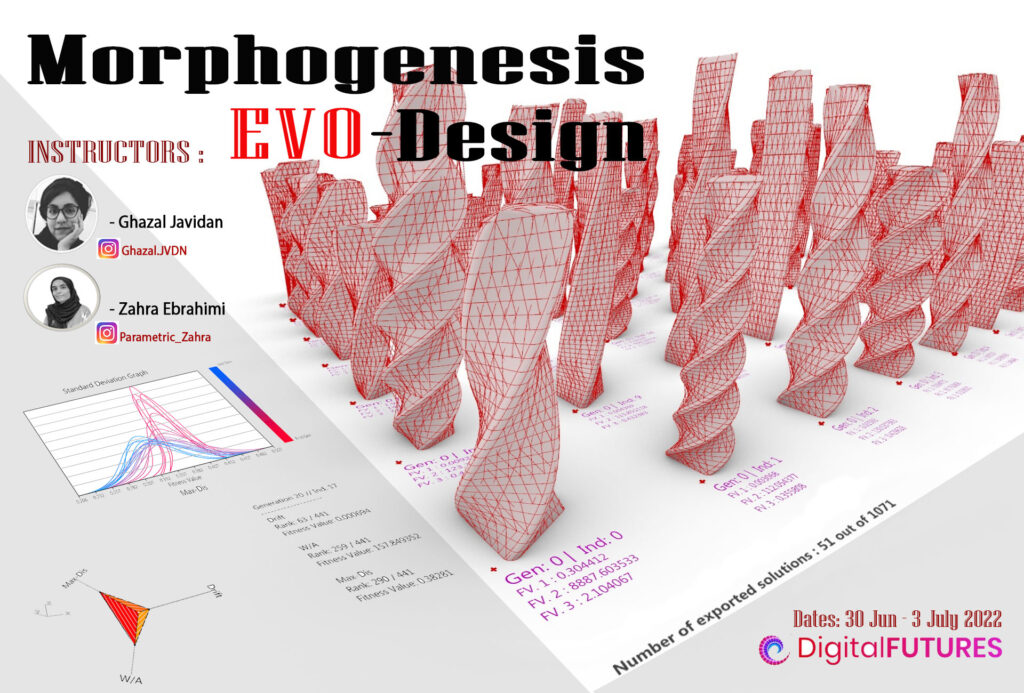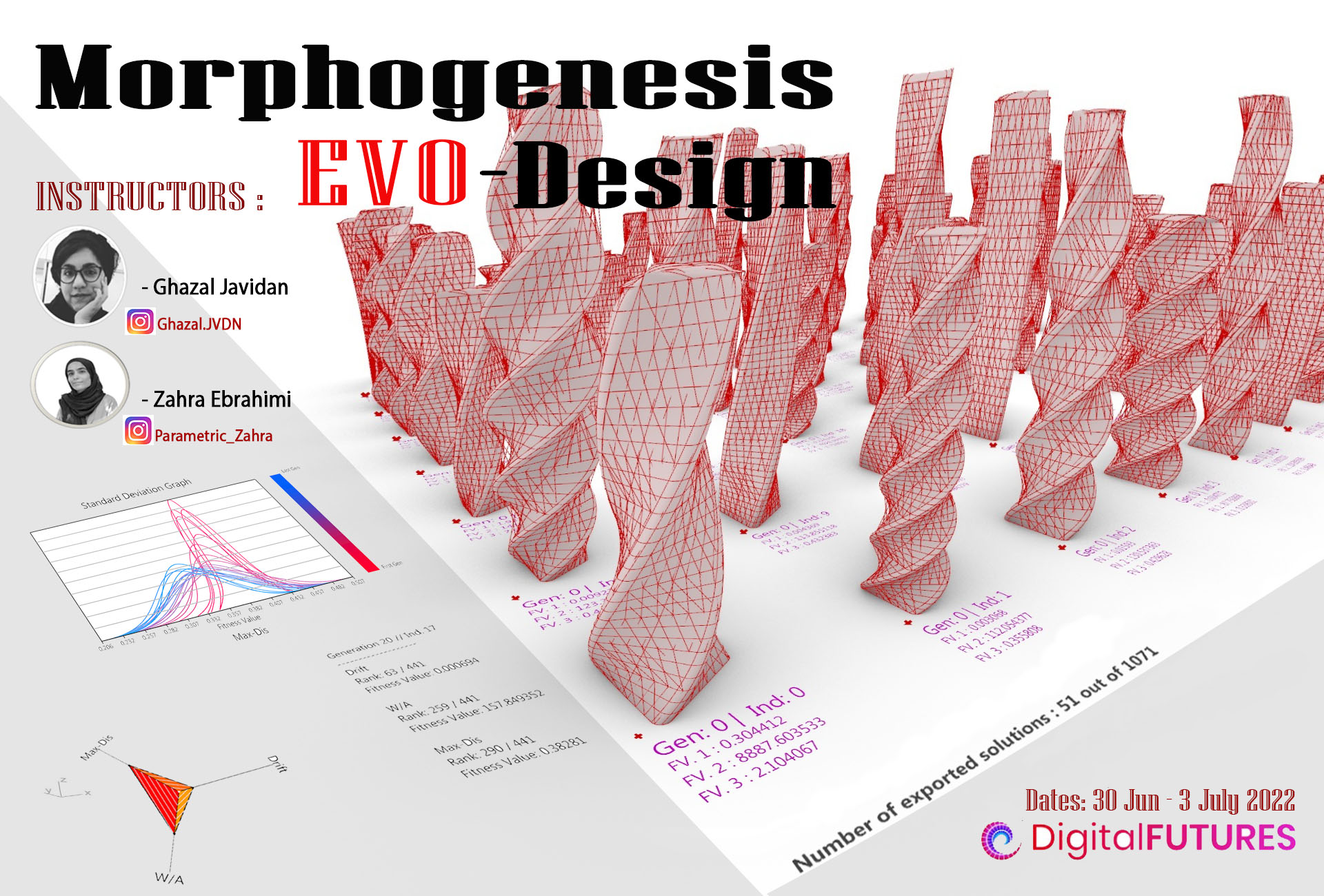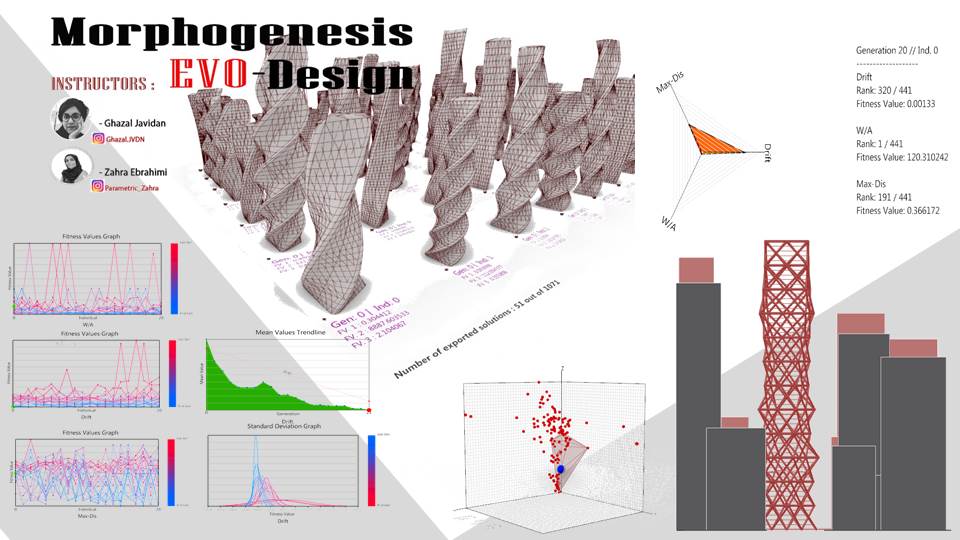
Description:
Required Skills: Grasshopper/ Intermediate
Required Software: Rhinocerios
Required Hardware: PC or Labtop
Maximum number of participating students: 30
This workshop would explore “Interactive Generative Design” with “Evolutionary Algorithms” (EAs) for “Tall Buildings” form-finding architectural design. In this workshop first, we explain the EAs algorithms and their optimization process from scratch. Then, we will continue with our main question “what if the final solution/s of our optimization process would be “Optimum” regarding the desirable “Performance” but not appropriate in the terms of “Architectural Form“?!” Having this question in mind, we practice intervening in the optimization process, controlling the variables affecting its performance, and exploring the whole solution-landscape and sub-optimal solutions instead of focusing only on the final result. The design criteria for tall building architectural form-finding would focus on “Aerodynamic” and “Seismic Resistance” design. The EAs optimization tools that study in the workshop include:
- Galapagos
- Octopus(https://www.food4rhino.com/en/app/octopus )
- Wallacei (https://www.wallacei.com/ )
- Biomorpher(https://www.food4rhino.com/en/app/evomass )
. این وورکشاپ به “طراحی تعاملی” فرم معماری ساختمان های بلند با استفاده از “الگوریتم های تکاملی” می پردازد. در این وورکشاپ ما ابتدا تمامی ادبیات موضوع مفاهیم اولیه الگوریتم های تکاملی و فرآیند بهینه سازی با این الگوریتم ها را از پایه توضیح می دهیم. سپس به این سوال می پردازیم : ا:
“اگر در پایان فرآیند بهینه سازی فرم/های نهایی از نظر عملکرد مورد انتظار “بهینه” بودند اما “هندسه و فرم معماری” مطلوب یا قابل قبولی نداشتن چه باید کرد؟
برای پاسخ به این سوال ما به بررسی چگونه تعامل و کنترل فرآیند بهینه سازی، تحلیل و آنالیز نتایج بهینه و نیمه بهینه در فضای چندبعدی بهینه سازی می پردازیم. در پایان این وورکشاپ شرکت کنندگان می آموزند که به جای اینکه تنها بر نتیجه/نتایج نهایی بهینه سازی تمرکز کنند، با کل فرآیند بهینه سازی تعامل کرده و تمام نتایج تولید شده در نسل های مختلف را بررسی کرده تا علاوه بر نتایج “بهینه” در جستجوی “فرم” هم به نمونه های مطلوب دست یابند
. معیارهای طراحی برای فرمیابی معماری ساختمانهای بلند در این وورکشاپ بر طراحی «آیرودینامیک» و «مقاومت لرزهای»تمرکز دارد.
Schedule:
timezone: (GMT +3:30) Tehran| Start time | End time | Description |
|---|---|---|
| 2022-06-30 - 10:00 | 2022-06-30 - 16:00 | Day 1-Introduction and lecture: Evolutionary Algorithms (EAs) and Interactive Generative Design; How to interact with EAs?! |
| 2022-07-01 - 10:00 | 2022-07-01 - 16:00 | Day 2- Introduction and lecture: Performance-based Tall Building design ; Wind and & Seismic design criteria. |
| 2022-07-02 - 10:00 | 2022-07-02 - 16:00 | Day 3-Morphogenesis EVO-design: Technical tutorial and Design push; analysis of optimization, reformulate design problem, re-iterate the optimization process. |
| 2022-07-03 - 10:00 | 2022-07-03 - 16:00 | Day 4 -Delivery and final presentation. |
Instructors:
 |
Ghazal Jaavidan | I am currently a Ph.D. researcher at Tarbiat Modares University, Tehran, Iran. As an architect, I have always been curious about building structures and how architectural decisions would affect them. Pursuing this curiosity, I have studied computational design and architectural-structural form-finding issues during my M.Arch and Ph.D. My expertise is in "Generative and Interactive" architectural design based on buildings’ structural performance. Specifically, I am working on tall buildings’ architectural form-finding using Evolutionary Algorithms (EAs). I have done multiple research projects with various EAs and genetic algorithms (GAs) and have published multiple papers on seismic architecture, generative design, multi-object optimization, and tall building form-finding. |
 |
Zahra Ebrahimi | I'm a graduate of master of architectural technology from pars institute of higher education of architecture and art and I got my bachelor's degree in architecture from Shahrekord university. As a computational designer, I'm very interested in writing algorithms in Grasshopper. Grasshopper is an visual programming and one of the most important algorithmic modeling tools. I am the author of the algorithm for the Parametric House site. This site focuses on Grasshopper and generates courses and new ideas for parametric design. I'm interested in writing kinetic and responsive facade algorithms, and in this field I have participated in international architectural competitions as a responsive designer as a member of the team. |
Disclaimer:
All workshops will accept 100 applications MAX.


